
The Asiloidea comprise a very large superfamily insects in the order Diptera, the true flies. It has a cosmopolitan distribution, occurring worldwide. It includes the family Bombyliidae, the bee flies, which are parasitoids, and the Asilidae, the robber flies, which are predators of other insects.

The Asilidae are the robber fly family, also called assassin flies. They are powerfully built, bristly flies with a short, stout proboscis enclosing the sharp, sucking hypopharynx. The name "robber flies" reflects their expert predatory habits; they feed mainly or exclusively on other insects and, as a rule, they wait in ambush and catch their prey in flight.

The Therevidae are a family of flies of the superfamily Asiloidea commonly known as stiletto flies. The family contains about 1,600 described species worldwide, most diverse in arid and semiarid regions with sandy soils. The larvae are predators of insect larvae in soil.
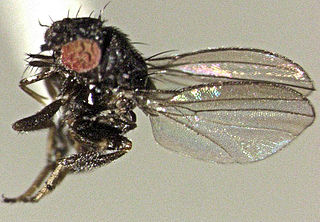
Milichiidae are a family of flies. Most species are very small and dark. Details of their biology have not yet been properly studied, but they are best known as kleptoparasites of predatory invertebrates, and accordingly are commonly known as freeloader flies or jackal flies. However, because of the conditions under which many species breed out, they also are known as filth flies.
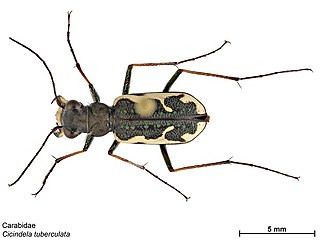
Neocicindela tuberculata is a species of tiger beetle in the family Cicindelidae, endemic to New Zealand. Its common names include common tiger beetle, moeone, and papapa, and in its laval stage penny doctor, butcher boy, kapuku, kui, kurikuri, moeone, and muremure. Neocicindela tuberculata was the first carabid beetle described from New Zealand. The species can run as fast as 5 miles per hour and are considered to be the fastest running beetles. Adult species prefer clay banks in summer and are good predators when in comes to insects.

Blepharotes coriarius, the giant yellow robber fly, is a species of large predatory fly from Australia in the family Asilidae. It was described by the German naturalist Christian Rudolph Wilhelm Wiedemann in 1830.

Laphria is a genus described by Johann Wilhelm Meigen in 1803, belonging to the family Asilidae, subfamily Laphriinae. Members of this genus are known as bee-like robber flies. This genus has a Holarctic distribution, occurring in Europe, Asia, and North America. They prey on a variety of insects, including other robber flies, bees, wasps and beetles. Like other asilids, they use their proboscis to penetrate the body of their prey and inject enzymes which dissolve the tissues.

Choerades is a genus of robber flies described by Francis Walker in 1851, belonging to the family Asilidae, subfamily Laphriinae.
Diptera is an order of winged insects commonly known as flies. Diptera, which are one of the most successful groups of organisms on Earth, are very diverse biologically. None are truly marine but they occupy virtually every terrestrial niche. Many have co-evolved in association with plants and animals. The Diptera are a very significant group in the decomposition and degeneration of plant and animal matter, are instrumental in the breakdown and release of nutrients back into the soil, and whose larvae supplement the diet of higher agrarian organisms. They are also an important component in food chains.

Melanostoma fasciatum is a species of hoverfly found in New Zealand, where it is common in agricultural fields and gardens. Locally dense populations of this hoverfly species might effectively reduce pest infestation. Hence, they are perhaps an effective natural and non-toxic bioagent that may control and reduce aphid and small caterpillar populations.
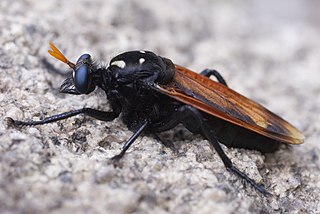
Prolepsis is an insect genus of mainly neotropical Diptera in the family Asilidae or robber flies.

Efferia is an insect genus of mainly neotropical and nearctic Diptera in the family Asilidae or robber flies. It is one of the most species-rich genera of Asilidae, with particularly high diversity in arid or semi-arid ecosystems of the New World.

Diogmites is a genus of mainly neotropical flies in the family Asilidae or robber flies.

Neoitamus cyanurus, the common awl robberfly, is a species of 'robber fly' belonging to the family Asilidae.
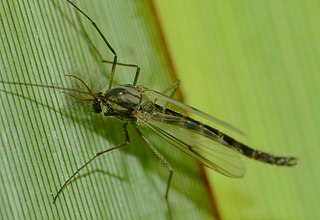
Chironomus zealandicus, commonly known as the New Zealand midge, common midge, or non-biting midge, is an insect of the Chironomidae family that is endemic to New Zealand. The worm-like larvae are known to fisherman and have a common name of blood worm due to their red color and elongated blood gills.

Neoitamus is a genus of robber flies in the family Asilidae. There are at least 60 described species in Neoitamus.

Mallophora bomboides, also known as the Florida bee killer, is a predaceous species of robber fly of the family Asilidae that feeds primarily on bumblebees. M. bomboides is a noteworthy instance of Batesian mimicry given its close resemblance to its prey, the bumblebee. These bees are typically found in the Eastern and Southern regions of the United States like South Carolina and Florida.
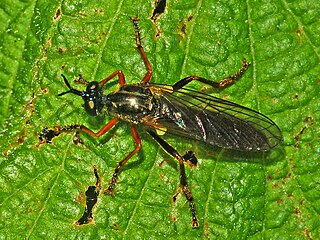
Dioctria rufipes, the common red-legged robberfly, is a species of robber fly in the subfamily Dasypogoninae of the family Asilidae.

Neoitamus cothurnatus, the scarce awl robberfly, is a species of 'robber fly' belonging to the family Asilidae.
Mallophora ruficauda is a species of parasitic robber fly in the family Asilidae, endemic to South and Central America. Like other robber flies, M. ruficauda is known for its aggressive behavior and predation upon other insects, especially bees. M. ruficauda mimics a bumblebee to fool predators into thinking it has a painful sting and is not worth eating.


















